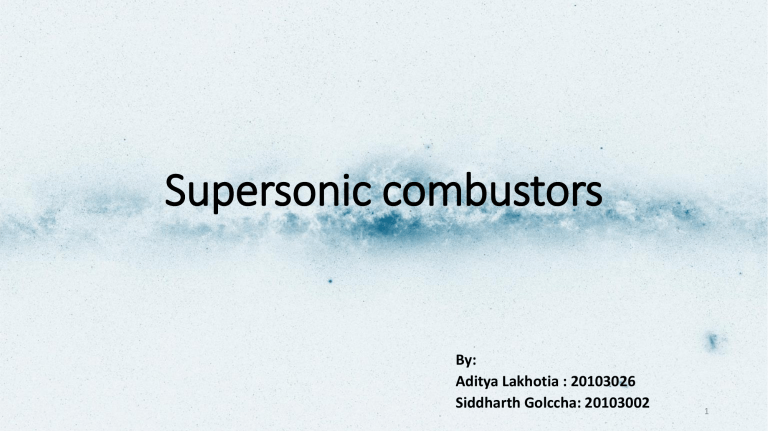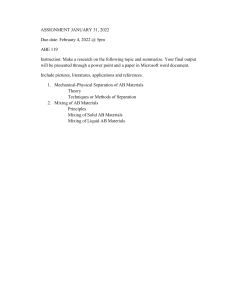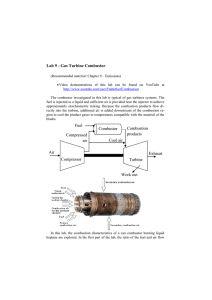20103026 20103002 supersonic combustion
advertisement

Supersonic combustors By: Aditya Lakhotia : 20103026 Siddharth Golccha: 20103002 1 This seminar will include a discussion on: • The requirements for supersonic combustion to occur • factors that influence the effectiveness and efficiency of combustion in supersonic flows • The various configurations of supersonic combustors and their working 2 A recap on SCRAMJETS.... • Ram effect and its significance • Why supersonic combustion? • Difficulties with combustion in supersonic flows 3 Features characteristic to supersonic combustion • Degree of complexity • Considerable challenge of experimental setup and computational complexity • Experimental - Costs involved due to • requirements of advanced materials • Fuels such as hydrogen can be difficult to work with • System control for accurate combustion stability and shock location • • • Computational -Non-linear nature of governing equations at hypersonic speeds Two other factors that affect the above: Large range of time scales and length scales 4 Time Scales • Equilibrium chemistry vs frozen chemistry • Residence time • Heat release time • Ignition delay time • Burn time • Time/ rate governing factors 5 Fuel-air mixing • The most critical process for the purpose of heat release • Combustion efficiency and effectivity • Fuel – air ratio and equivalence ratios • Time constraints • Scales of size in mixing • Large scale turbulent mixing • Intermolecular diffusion and molecular level mixing Figure : Plot of equilibrium temperature with air- fuel ratio – source : https://doi.org/10.1016/j.cja.2021.06.002 6 Fuel – air mixing • Premixed and non-premixed combustion • Mixing mechanisms: • Overlap of multiple elementary mixing types – diffusion, turbulent mixing, recirculation • Parallel, compressible flows • Shear layer mixing • Turbulent mixing • Mixing enhancers 7 Fuel-air mixing • Shear Layer Mixing • Factors affecting development of shear layer • Velocity • Temperature • Compressibility of flows • Mixing within the shear layer Fig: Development of the shear layer between parallel flows Fig: Transition to turbulent structures in a 2D shear layer 8 Fuel injection • Reiterate : need for rapid mixing • Angles of fuel injection • Transverse • Oblique • Injection configurations • Mechanism 9 Mixing Enhancers • Ramps and hypermixers • Advantages of using a ramp • To avoid the strong shocks associated with transverse injection • Ramp configuration: • Swept vs unswept ramps • Selecting a ramp angle 10 Mixing Enhancers Fig : vortical structures that lift the fuel from the wall and enhance mixing 11 Flame holding and flame stability • Time constraints: • unless a flame-holding mechanism is in place to extend the residence time, the exothermic chemical reactions cannot be completed within the combustion chamber • achieving a balance between the flame propagation speed and the fluid velocity • Flame-holding issue is solved by the generation of some sort of recirculation region that ensures sufficient residence time • Role of the recirculation region • Preventing blowout • Flame instability and unstart 12 Flame stability – recirculation region Fig: Recirculation region for a rearward step combustor 13 Flame stability and unstart Figure – plot of the dependence of onset of unstart on the equivalence ratio Source : doi.org/10.1016/j.energy.2 020.119271 14 Flammability limit and blowout 15 Role of isolator Figure: Plot of the Ratio of the backpressure to the max pressure of the isolator required to avoid unstart 16 Types of Combustor 17 For Subsonic regime • Can type • Annular type • Canular type 18 19 Can type combustors 20 Annular type combustors 21 22 Cannular type combustors 23 For Supersonic regime • No moving parts are available in the scramjet engine, which gives higher thrust to weight ratio compared with any other propulsion engines. • Different techniques and approaches are used for getting better results in the form of improved mixing, momentum, drag 24 Types of Supersonic combustors • Step Combustors • Isolator Combustors • Wall-jet injection combustors • In-stream injection combustors • Hypermixer injection combustors 25 Step Combustors • Used to reduce the BL separation problem • A3/A2 >1 • Fuel injected in close proximity to the base of the step • Helps in providing small subsonic recirculation regions for ignition and flame holding • Flow characteristics downstream of the of the step are very complex and generally not amenable to insightful 1-D flow approximations, only applicable to exit of station 3 that is combustor exit. 26 Step Combustors 27 28 Isolator Combustors • Inlet isolator + Increased area combustor • Types of increased area combustor - Step combustor - Divergent area wall combustor 29 Isolator Combustors 30 Isolator Combustors 31 Isolator Combustors 32 Combustor energy balance 33 Wall jets, In-stream and Hypermixer 34 • Walljets Give rise of net heat flux around the walls. 35 • Fuel injected axially downstream to the flow • High combustor velocities leads to increased distance (combustor length) to achieve adequate mixing 36 37 • Hypermixers have the maximum momentum recovery from the fuel (The importance of which increases with flight mach number) due to the axial angled downstream fuel injection • Challenge with hypermixer is to achieve adequate mixing of nearly axially injected fuel in reasonable combustor lengths without offsetting drag increases 38 39


